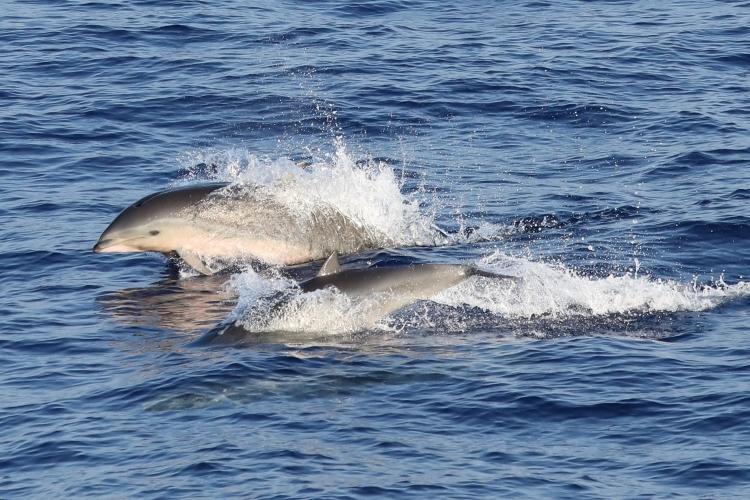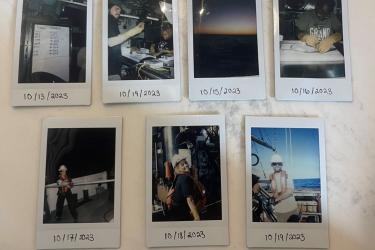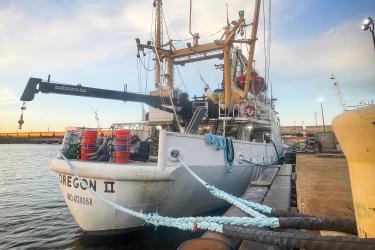Day 4: A Stellar Day of Numerous Sightings
The team got lucky again with another stellar day on the water! Marine mammal observers collected valuable data during 19 different sightings. The acoustics team remained busy with different marine mammal sounds coming through from the array and the bird specialists tallied a notable number of birds.
The marine mammal observers began calling in sightings shortly after starting observations for the day. The first sightings included several groups of dolphins and pygmy or dwarf sperm whales. A group of Risso's dolphins came in close to the boat, so the team was able to get a good look at them.
Risso’s dolphins are unique. They have a distinctive body shape and a prominent vertical crease on the front of their bulbous head. They also have a tall, slender dorsal fin that sticks high out of the water and they are the most heavily scarred dolphins. The scars are thought to result from the suckers and beaks of squid (one of their favorite meals) or the teeth of other Risso’s dolphins.
The bird scientists had an impressive day and counted more than 400 seabirds. Among them were band-rumped storm petrels, wilson storm petrels, Audubon’s shearwaters, brown boobies, and a large flock of sooty terns.
The acousticians heard multiple species, such as the pygmy or dwarf sperm whales, as well as different dolphins at various frequencies and clicks. These were able to augment the visual sightings data from the day.
Day 5: Featuring False Killer Whales, Audubon Shearwaters, and a Lot of Dolphins
We woke up to a stunning morning! The sunrise was vibrant, the waters were calm, and the air had a slight breeze. These are the days marine scientists hope for. The observers took their assigned spots on the deck and the acousticians, as well as data recorders made their way to the lab to start at 6:30 a.m. sharp.
The marine mammal team had a big day with many dolphin sightings. Unfortunately, many were spotted off in the distance, making it challenging to distinguish the species. However, the highlight of the day was the sighting of false killer whales.
Tom Ninke described, “When I sighted the false killer whales through the big eyes they were breaching, cartwheeling through the air, and jumping out of the water. It was really exciting to see!”
The excitement continued shortly after with a clear view of a water spout off in the distance. It was far enough away that the ship and crew were not in danger, so the team was able to continue their work.
For the bird team, Audubon shearwaters have been a compelling species to watch. Christopher Haney, a scientist specializing in birds explained, “Audubon shearwaters breed outside the Gulf of Mexico, but they migrate into the Gulf after breeding. The closest colony is on Cay Sal Bank, an archipelago off northern Cuba, but actually under Bahamian jurisdiction. So, it is very exciting to see them dispersing as groups into the Gulf this time of the year.”
After the day was finished a few scientists went to the bow to conquer a cardio kick-boxing workout. As the sun was setting a group of Atlantic spotted dolphins came in to ride the bow. It was a perfect end to a great day of collecting data!
Day 6: First Spinners, Then Clicks, and Later Webbed Red Feet
“Uber, flying bridge, I have a cue. 60 right, reticle 1.5, marine mammal.” A rendition of this statement was sounding through the radio all morning from the observers to the data recorders. The radio communication is essential for observers to tell the data recorders in the lab exactly where the animals are (distance and angle from the ship) when they are first sighted. The conditions were excellent, which gave the observers the best opportunity to collect more sightings.
The marine mammal observers spotted groups of various dolphin species throughout the day. The team had their first sightings of spinner dolphins for the trip, which was captivating. The team also saw another group of Risso’s dolphins and multiple sperm whales!
“On top of the great morning we had with sightings, we were also able to collect two more biopsy samples of pantropical spotted dolphins. Assisting with the biopsies has been an awesome learning opportunity for me and I have been thrilled to assist with such a niche project,” Heidi Malizia, a marine mammal scientist explained.
Acousticians were able to track the sperm whales from bow to stern of the vessel. Sperm whales are more challenging to spot for the observers because they frequently spend up to one hour underwater at a time. However, for the acousticians the sperm whales are fun detections because the team can distinguish individuals and know their relative location even if the observers cannot see the entire group.
The bird specialists were able to finally see a red-footed booby they had been waiting for. Only a few pairs breed in the southern Gulf of Mexico, on Mexico’s Campeche Bank, so finding even a single bird is much like finding one needle in a large haystack. One reason this seabird is so scarce in the Gulf is that it needs brushy vegetation on isolated islands for nesting, but frequent hurricanes tend to scour vegetative growth off this region’s low-lying cays.
As the morning turned into afternoon, the team spotted a leatherback sea turtle swimming by the side of the vessel. This was the icing on the cake of an already successful day. Leatherback sea turtles are the largest turtles on the planet, they are impressive divers, and they can travel over 10,000 miles annually. This was a surprising sighting for the books.
Ending the First Leg on a Great Note
Felipe Triana, a marine mammal scientist stated, “After several years of field experience in the Gulf of Mexico, I was able to see Fraser’s dolphins for the first time! It was momentous.”
Sightings of Fraser's dolphins occur only sporadically. Since the early 1990s there have been only a handful of sightings during our ship-based surveys. Although studies suggest that this dolphin is a resident of the Gulf of Mexico, we don’t know how this population relates to others in the Western North Atlantic.
Meet the Blogger
Ellie Hartman
Ellie Hartman was born and raised in Breckenridge, Colorado. She was a communications intern, research assistant, and marine mammal observer for NOAA's Southeast Science Center. She graduated from Barry University with a Master's of Business Administration and graduated from University of Miami with a Master's of Professional Science in Marine Conservation. Meet Ellie












